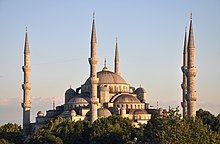
Back Meuseujid ACE Moskee Afrikaans Moschee ALS መስጊድ Amharic Mezquita AN मस्जिद ANP مسجد Arabic جامع ARY جامع ARZ মছজিদ Assamese

| Bagian dari seri |
| Islam |
|---|
 |
Masjid (serapan dari Arab: مَسْجِد, translit. masjid, pelafalan [mǝsdʒid]; secara harfiah "tempat sujud"), merupakan tempat salat bagi umat Islam.[1] Masjid biasanya tertutup bangunan, tetapi bisa menjadi tempat salat (sujud) dilakukan, termasuk halaman luar.[2][3]
Awalnya masjid adalah tempat salat sederhana bagi umat Islam, dan mungkin merupakan ruang terbuka daripada bangunan.[4] Pada tahap pertama arsitektur Islam, 650-750, masjid terdiri dari ruang terbuka dan tertutup yang dikelilingi oleh dinding, seringkali dengan menara tempat azan dikeluarkan.[5] Bangunan masjid biasanya berisi mihrab dipasang di dinding yang menunjukkan arah Kiblat ke Makkah,[1] dan fasilitas wudu.[1][6] Mimbar, tempat di mana khutbah salat Jumat disampaikan, dulunya adalah karakteristik masjid pusat kota, tetapi sejak itu menjadi umum di masjid-masjid kecil.[7][1] Masjid biasanya memiliki ruang terpisah untuk pria dan wanita.[1] Pola dasar organisasi ini mengambil bentuk yang berbeda tergantung pada wilayah, periode, dan mazhab.[6]
Masjid umumnya berfungsi sebagai lokasi untuk salat, buka puasa Ramadan, salat Jenazah, pelaksanaan pernikahan dan bisnis, pengumpulan dan distribusi sedekah, serta tempat penampungan tunawisma,[1][7] tempat tinggalnya orang-orang bertakwa, tempat berkumpul kaum muslimin setiap hari, markas untuk mengadakan muktamar (pertemuan besar), tempat bermusyawarah dan saling memberi nasehat, tempat bertemu untuk saling mengenal dan persatuan, dan tempat menumbuhkan semangat saling tolong menolong dalam kebaikan.[8] Secara historis, masjid telah berfungsi sebagai pusat komunitas, pengadilan, dan sekolah agama. Di zaman modern, mereka juga mempertahankan perannya sebagai tempat pengajaran dan debat agama.[1][7] Kepentingan khusus diberikan kepada Masjidilharam (pusat haji), Masjid Nabawi di Madinah (tempat pemakaman Muhammad) dan Masjidilaqsa di Yerusalem (diyakini sebagai tempat kenaikan Muhammad ke surga).[1]
Dengan penyebaran Islam, masjid berlipat ganda di seluruh dunia Islam. Terkadang gereja dan kuil diubah menjadi masjid, yang memengaruhi gaya arsitektur Islam.[7] Sementara sebagian besar masjid pra-modern didanai oleh sumbangan amal,[1] peningkatan peraturan pemerintah tentang masjid besar telah diimbangi dengan munculnya masjid yang didanai swasta, banyak di antaranya berfungsi sebagai basis untuk berbagai organisasi revivalis Islam dan aktivitas sosial.[7] Masjid telah memainkan sejumlah peran politik. Tingkat kehadiran masjid sangat bervariasi tergantung pada wilayah.
- ^ a b c d e f g h i John L. Esposito, ed. (2014). "Mosque". The Oxford Dictionary of Islam. Oxford University Press.
- ^ Longhurst, Christopher E; Theology of a Mosque: The Sacred Inspiring Form, Function and Design in Islamic Architecture, Lonaard Journal. Mar 2012, Vol. 2 Issue 8, p3-13. 11p. “Since submission to God is the essence of divine worship, the place of worship is intrinsic to Islam’s self-identity. This ‘place’ is not a building per se but what is evidenced by the etymology of the word ‘mosque’ which derives from the Arabic ‘masjid’ meaning ‘a place of sujud (prostration).’
- ^ Colledge, R. (1999). The mosque. In: Mastering World Religions. Macmillan Master Series. Palgrave, London. https://doi.org/10.1007/978-1-349-14329-0_16 “A mosque is a building where Muslims bow before Allah to show their submission to His will. It is not necessary to have a building to do this. Muhammad said that ‘Wherever the hour of prayer overtakes you, you shall perform the prayer. That place is the mosque’. In his early days in Makkah there was no mosque, so he and his friends would pray anywhere.”
- ^ Grabar 1969, hlm. 34: "The main characteristic, then, of this first stage was the creation of a space which served exclusively Muslim purposes and which, in cities that were entirely Muslim, existed on two separate levels of exclusivity. The word masjid is always associated with these spaces, but it does not yet possess any formal structure nor does it have any precise function other than that of excluding non-Muslims."
- ^ Grabar 1969, hlm. 34-35: "A second stage occurred between 650 and 750. To my knowledge, twenty-seven masjids from this period are archaeologically definable… All mosques had a certain relationship between open and closed covered spaces. The problems posed by this relationship pertain primarily to the history of art, except on one point, which is the apparent tendency to consider the covered parts as the bayt al-salat, i.e. place of prayer, and the rest of the building as an overflow area for prayer. All these buildings were enclosed by walls and did not have an exterior façade. Their orderly form appeared only from the inside where the balance between open and covered spaces served, among other things, to indicate the direction of qibla. Their only outward symbol was the minaret, a feature which appeared early in mosques built in old cities with predominantly non-Muslim populations and only later in primarily Muslim ones."
- ^ a b Nuha N. N. Khoury (2009). "Mosque". Dalam Juan Eduardo Campo. Encyclopedia of Islam. Infobase Publishing.
- ^ a b c d e Patrick D. Gaffney (2004). "Masjid". Dalam Richard C. Martin. Encyclopedia of Islam and the Muslim World. MacMillan Reference.
- ^ Wanili, Khairuddin (2014). ENSIKLOPEDI MASJID. Jakarta Timur: Darus Sunnah Press. hlm. xiii. ISBN 9789793772707.
© MMXXIII Rich X Search. We shall prevail. All rights reserved. Rich X Search